Diurnal, Temporal and Spatial Variations of Main Air Pollutants Before and during Emergency Lockdown in the City of Novi Sad (Serbia)
Abstract
1. Introduction
2. Materials and Methods
2.1. Study Area
2.2. Air Pollution Monitoring at National, Regional and Local Networks at Novi Sad
- NN1, Novi Sad-Rumenačka (air quality variables that are monitored: SO2, NO2, CO, PM10, PM2.5, wind direction, wind speed) type of station: traffic (Lat/Long: 45.26263°, 19.81902°)
- NN2, Novi Sad—Liman (air quality variables that are monitored: SO2, O3, NO2, CO) type of station: background (Lat/Long: 45.23864°, 19.83570°)
- RN1, Novi Sad—Šangaj (air quality variables that are monitored: BTEX, H2S, SO2, t, RH, wind direction, wind speed), type of station: industrial, (Lat/Long: 45.27237°, 19.87333°)
- LN1, Novi Sad—Intersection of Rumenačka and Bulevar Jaše Tomića, type of station: urban/traffic, (Lat/Long: 45.26348°, 19.81903°)
- LN2, Kać—Kralj Petar 1, type of station: suburban/traffic, (Lat/Long: 45.29980°, 19.93926°)
- LN3, Novi Sad- Sunčani kej 41, type of station: urban/background, (Lat/Long: 45.24000°, 19.85139°)
- LN4, Sremska Kamenica, Kamenički park 1-14, type of station: suburban/background, (Lat/Long: 45.22931°, 19.84898°)
2.3. Ongoing Sampling Campaign with Low-Cost Sensors and Reference Pumps
3. Results and Discussion
3.1. Descriptive Statistic of PM2.5 Levels before and at the Beginning of Emergency Measure State Measured with Low-Cost Sensors
3.2. Changes in Diurnal Variation of PM2.5 at Sampling Site MS1, MS2, MS3 and MS5 before and after Measures of the State Emergency
3.3. Changes in Diurnal Variation of Gaseous Pollutants and PM2.5 at NN1 before and after Measures of the State Emergency
- Daily profiles of SO2, the main pollutant, depicted in the form of a boxplot (Figure 6a), show that, on average, there was no noticeable change a week before and 10 days during the emergency state. For most hours of day, the SO2 concentration was below 20 μg/m3, with occasional “outliers” in the range from 35–40 μg/m3 in the morning and afternoon pollution peaks.
- Daily profiles for NOx show a clear change in daily patterns (Figure 6b). Because boxplot color corresponds to the value of median, it is evident that the median of these main pollutants was reduced during the first 10 days of the emergency state during most hours of the day. NOx boxplots show clear morning and afternoon pollution peaks, both before and during the emergency state, but the median of these peaks is reduced during the emergency state. The median was around 80–95 μg/m3 before emergency state from 18–19 h, and an evident reduction to the median of about 15–25 μg/m3 is visible during the emergency state. Additionally, during the most active hours of the day (period from 9 h to 17 h), a noticeable drop in the level of air pollution was observed, indicated by lower median and smaller interquartile range (median around 50 μg/m3 before emergency state during this time of day, and about 25 μg/m3 during emergency state in this time of day).
- Observing CO daily profiles following conclusions can be reached. During the active hours of the day, in the period from 9 h to 17 h, the level of air pollution stayed similar in, going around 0.8 mg/m3 with a relatively narrow interquartile range (Figure 6c). During morning hours, the situation is similar, with a slight increase during the emergency state, with median still being in the range from 0.8 to 1 mg/m3, but with larger interquartile ranges during the emergency state. On the other hand, from 18 h to 23 h, there is a slight reduction in the CO level during the emergency state. Since there are no noticeable changes in the daily profiles before and during the emergency state for CO levels, it can be argued that pollutants with domestic heating source profiles mostly exhibited constant levels.
- An interesting increase in PM2.5 levels in the early morning and in the nighttime at different monitoring sites over the area of the city of Novi Sad, even during lockdown, has also been noticed (Figure 6d). However, during the most active hours of the day (period from 9 h to 17 h) a noticeable drop in the level of air pollution was evident, as indicated by a lower median and smaller interquartile range.
4. Conclusions
Author Contributions
Funding
Institutional Review Board Statement
Informed Consent Statement
Data Availability Statement
Acknowledgments
Conflicts of Interest
Appendix A
Field Calibration of PM2.5 Low-Cost Device Performed via Collocation with Reference Pump

Appendix B
HYSPLIT Analysis of Sand Episode Originating from Aralkum Desert
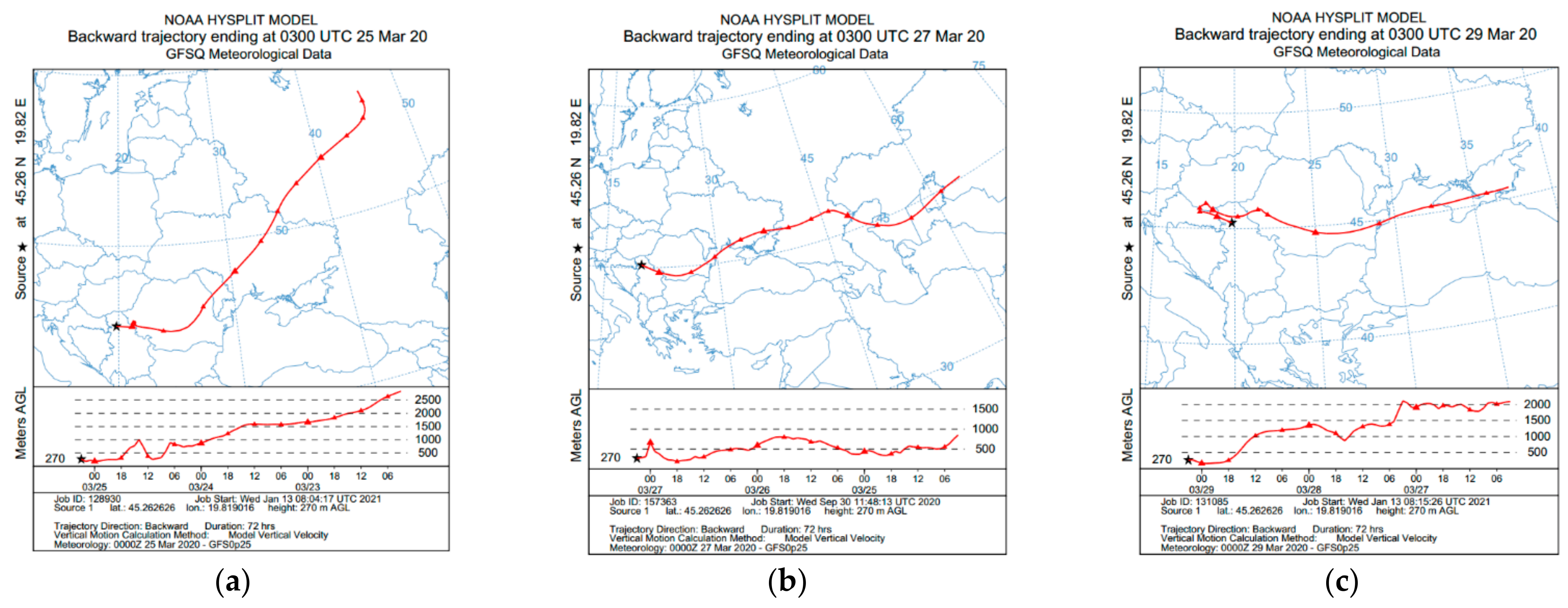
Appendix C
Correlation of PM2.5 Concentration in the City of Novi Sad between Spatially Distributed Measuring Sites


Appendix D
Changes in Diurnal Variation of Gaseous Pollutants at NN2 before and after Measures of the State Emergency
- Daily profiles of SO2, the main pollutant, depicted in the form of a boxplot (Figure A5a), show that, on average, there is a slight change a week before and 10 days during the emergency state. In the week before, for most hours of day, SO2 concentration was approximately 5 μg/m3, while in the first 10 days of the emergency state, the median is a bit higher between 7 and 8 μg/m3 from midnight to morning hours and about 10 μg/m3 later on during the working hours and evening.
- Daily profiles for O3, the main pollutant, follow diurnal cycle with maximal levels from 10 to 16 h with a median of about 70 μg/m3 in the week before and 80 μg/m3 in the first 10 days of the emergency state (Figure A5b). During morning and evening hours, median values are also 10 μg/m3 lower in the week before (about 50 μg/m3) than in the first 10 days of the emergency state (60 about μg/m3). Interquartile ranges are larger during the emergency state in periods of day with maximal levels of O3.
- Daily profiles for NO, NO2 and NOx at Liman NN2 site, although lower in general, show a clear change in daily patterns similar to Rumenačka NN1 site. NOx boxplots (Figure A5c) show clear morning and afternoon pollution peaks, both before and during the emergency state, but the median of these peaks is reduced during the emergency state (median around 30–35 μg/m3 before emergency state from 18 to 19 h, and an evident reduction of the median of about 15 μg/m3 during the emergency state). In addition, during the most active hours of the day (period from 9 to 17 h), a significant drop in the level of air pollution can be observed, indicated by a lower median (median around 15–30 μg/m3 before the emergency state during this time of day, and about 10–15 μg/m3 during emergency state during this time of day).
- Observing CO daily profiles at Liman (Figure A5d), NN2 site, the following conclusions can be reached. During the active hours of the day, from 9 h to 17 h level of CO stayed similar, going between 0.4 and 0.5 mg/m3, with a narrower interquartile range during the emergency state. During morning hours, the median level is similar, but with larger interquartile ranges before the emergency state. Similar as at the Rumenačka site, from 18 to 23 h, there is a slight reduction in CO level during the emergency state. Daily profiles before and during the emergency state for CO levels are connected with domestic heating sources that stay the same and traffic, leading to a slight reduction.
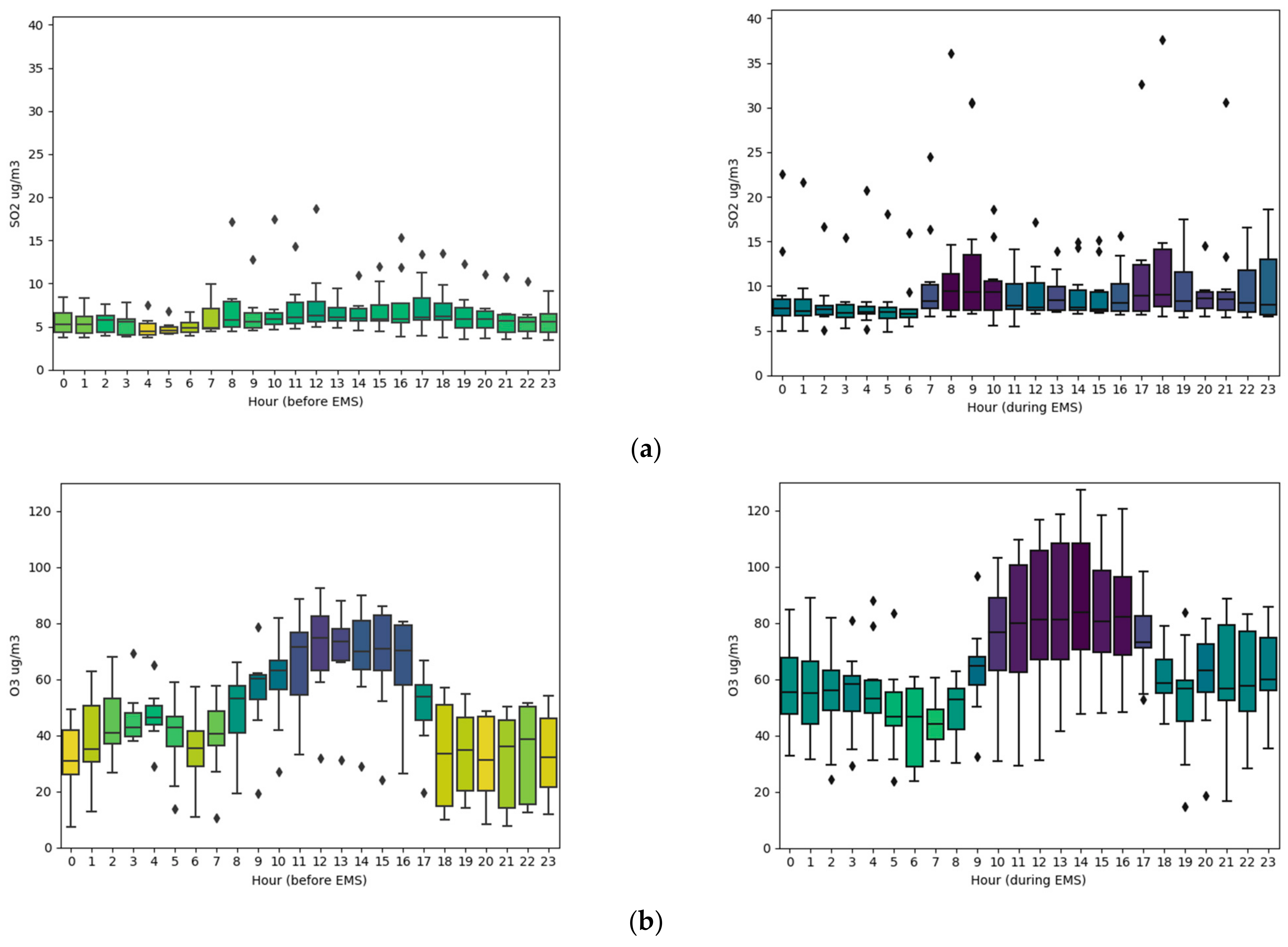
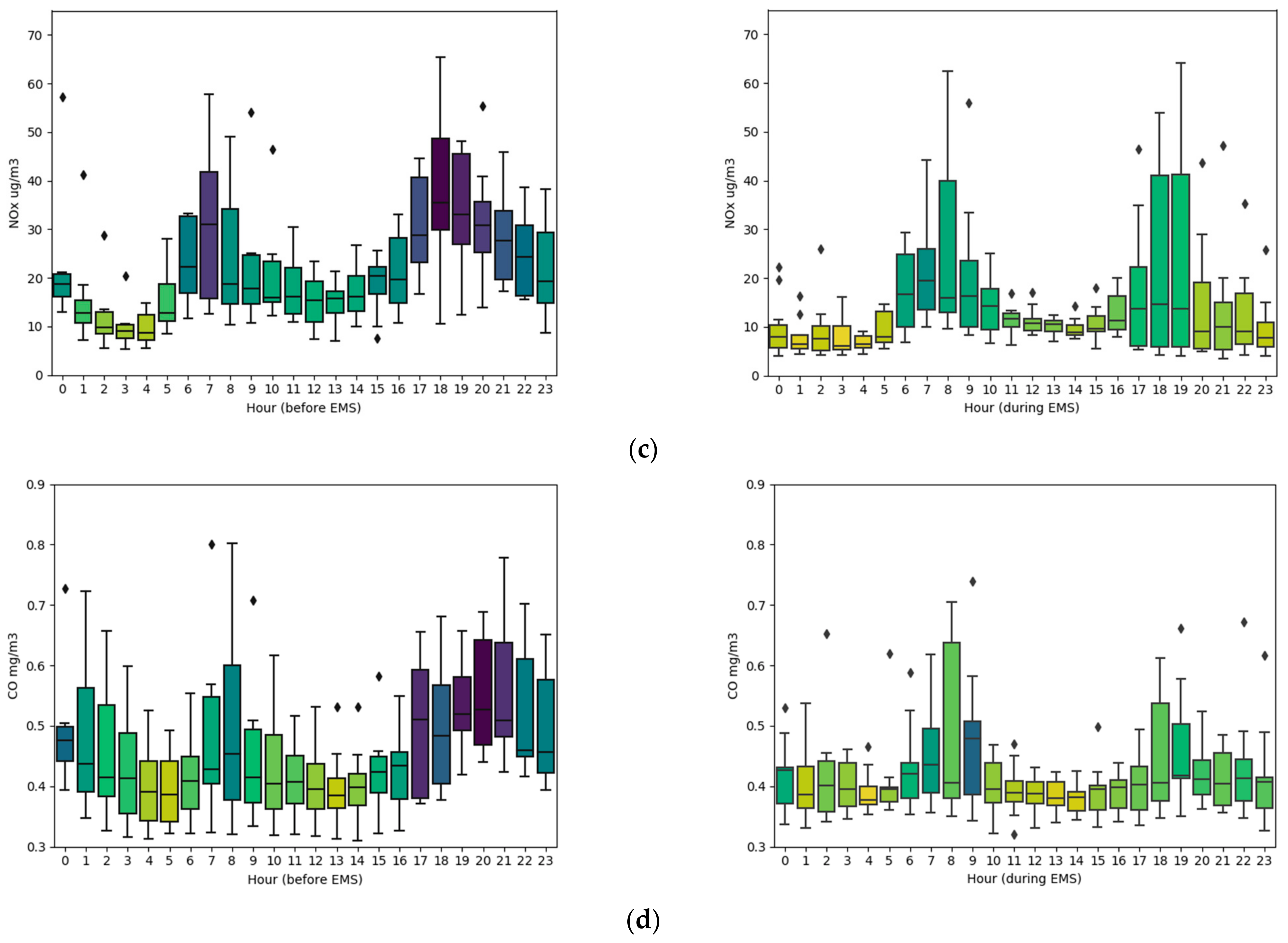
References
- Shrestha, A.M.; Shrestha, U.B.; Sharma, R.; Bhattarai, S.; Tran, H.N.T.; Rupakheti, M. Lockdown Caused by COVID-19 Pandemic Reduces Air Pollution in Cities Worldwide. 2020. Available online: https://eartharxiv.org/repository/view/304/ (accessed on 28 January 2021). [CrossRef]
- Sharma, S.; Zhang, M.; Anshika; Gao, J.; Zhang, H.; Kota, S.H. Effect of restricted emissions during COVID-19 on air quality in India. Sci. Total Environ. 2020, 728, 138878. [Google Scholar] [CrossRef] [PubMed]
- Muhammad, S.; Long, X.; Salman, M. COVID-19 pandemic and environmental pollution: A blessing in disguise? Sci. Total Environ. 2020, 728, 138820. [Google Scholar] [CrossRef] [PubMed]
- Dutheil, F.; Baker, J.S.; Navel, V. COVID-19 as a factor influencing air pollution? Environ. Pollut. 2020, 263, 2019–2021. [Google Scholar] [CrossRef] [PubMed]
- Li, L.; Li, Q.; Huang, L.; Wang, Q.; Zhu, A.; Xu, J.; Liu, Z.; Li, H.; Shi, L.; Li, R. Air quality changes during the COVID-19 lockdown over the Yangtze River Delta Region: An insight into the impact of human activity pattern changes on air pollution variation. Sci. Total Environ. 2020, 139282. [Google Scholar] [CrossRef] [PubMed]
- Giani, P.; Castruccio, S.; Anav, A.; Howard, D.; Hu, W.; Crippa, P. Short-term and long-term health impacts of air pollution reductions from COVID-19 lockdowns in China and Europe: A modelling study. Lancet Planet. Health 2020, 4, e474–e482. [Google Scholar] [CrossRef]
- European Environment Agency. Air Quality in Europe—2020 Report; European Environment Agency: Copenhagen, Denmark, 2020.
- INERIS. COVID Impact on Air Quality in Europe: A Preliminary Regional Model Analysis. Available online: https://policy.atmosphere.copernicus.eu/reports/CAMS71_COVID_20200626_v1.3.pdf (accessed on 1 December 2020).
- Serbian Environmental Protection Agency. Combined Review of Automatic Air Quality Monitoring in the Republic of Serbia. Available online: http://www.amskv.sepa.gov.rs/ (accessed on 12 February 2020).
- Provincial Secretariat for Urban Planning and Environmental Protection. Available online: http://www.ekourbapv.vojvodina.gov.rs (accessed on 12 February 2020).
- Monitoring the Air Quality of the City of Novi Sad. Available online: https://environovisad.rs/vazduh (accessed on 5 December 2020).
- Cleaner Air for All. Available online: https://ec.europa.eu/environment/air/cleaner_air/ (accessed on 5 December 2020).
- Petrović, J. Environmental Aspects of Thermal Power Plants Utilization in Novi Sad—Air Pollution. Ph.D. Thesis, University Educons, Faculty of Environmental Protection, Sremska Kamenica, Serbia, April 2017. [Google Scholar]
- WHO Regional Office for Europe. Health Impact of Ambient Air Pollution in Serbia, A Call to Action. Available online: https://serbia.un.org/en/22141-health-impact-ambient-air-pollution-serbia-call-action (accessed on 5 December 2020).
- Eeftens, M.; Tsai, M.-Y.; Ampe, C.; Anwander, B.; Beelen, R.; Bellander, T.; Cesaroni, G.; Cirach, M.; Cyrys, J.; de Hoogh, K. Spatial variation of PM2.5, PM10, PM2.5 absorbance and PMcoarse concentrations between and within 20 European study areas and the relationship with NO2–results of the ESCAPE project. Atmos. Environ. 2012, 62, 303–317. [Google Scholar] [CrossRef]
- DunavNet. Environmental Monitoring. Available online: https://dunavnet.eu/solutions/environmental-monitoring/ (accessed on 5 December 2020).
- Plantower. Digital Universal Particle Concentration Sensor, PMS7003 Series Data Manual. Plantower: 2016. Available online: https://download.kamami.com/p564008-p564008-PMS7003%20series%20data%20manua_English_V2.5.pdf (accessed on 5 December 2020).
- Levy Zamora, M.; Xiong, F.; Gentner, D.; Kerkez, B.; Kohrman-Glaser, J.; Koehler, K. Field and laboratory evaluations of the low-cost plantower particulate matter sensor. Environ. Sci. Technol. 2018, 53, 838–849. [Google Scholar] [CrossRef] [PubMed]
- Sven Leckel. LVS3 Poduct Page. Available online: https://www.leckel.de/ (accessed on 1 December 2020).
- Wang, J.; Ogawa, S. Effects of meteorological conditions on PM2. 5 concentrations in Nagasaki, Japan. Int. J. Environ. Res. Public Health 2015, 12, 9089–9101. [Google Scholar] [CrossRef] [PubMed]
- Menut, L.; Bessagnet, B.; Siour, G.; Mailler, S.; Pennel, R.; Cholakian, A. Impact of lockdown measures to combat Covid-19 on air quality over western Europe. Sci. Total Environ. 2020, 741, 140426. [Google Scholar] [CrossRef] [PubMed]
- Singh, V.; Singh, S.; Biswal, A.; Kesarkar, A.P.; Mor, S.; Ravindra, K. Diurnal and temporal changes in air pollution during COVID-19 strict lockdown over different regions of India. Environ. Pollut. 2020, 266, 115368. [Google Scholar] [CrossRef] [PubMed]
- Donzelli, G.; Cioni, L.; Cancellieri, M.; Llopis Morales, A.; Morales Suárez-Varela, M.M. The Effect of the Covid-19 Lockdown on Air Quality in Three Italian Medium-Sized Cities. Atmosphere 2020, 11, 1118. [Google Scholar] [CrossRef]
- Fu, F.; Purvis-Roberts, K.L.; Williams, B. Impact of the COVID-19 Pandemic Lockdown on Air Pollution in 20 Major Cities around the World. Atmosphere 2020, 11, 1189. [Google Scholar] [CrossRef]
- European Environment Agency. Air Quality and COVID19. Available online: https://www.eea.europa.eu/themes/air/air-quality-and-covid19 (accessed on 1 December 2020).
- Lee, C.-H.; Wang, Y.-B.; Yu, H.-L. An efficient spatiotemporal data calibration approach for the low-cost PM2. 5 sensing network: A case study in Taiwan. Environ. Int. 2019, 130, 104838. [Google Scholar] [CrossRef] [PubMed]
- Trilles, S.; Vicente, A.B.; Juan, P.; Ramos, F.; Meseguer, S.; Serra, L. Reliability Validation of a Low-Cost Particulate Matter IoT Sensor in Indoor and Outdoor Environments Using a Reference Sampler. Sustainability 2019, 11, 7220. [Google Scholar] [CrossRef]
- EUMETSAT. Aralkum Desert Dust Pollutes Air in South-East European Countries on March 27th. Available online: https://www.eumetsat.int/aralkum-desert-dust-pollutes-air-south-east-europe (accessed on 5 December 2020).
- Grimm Aerosol. MODEL EDM180 Product Page. Available online: https://www.grimm-aerosol.com/products-en/environmental-dust-monitoring/approved-pm-monitor/edm180-the-proven/ (accessed on 1 December 2020).
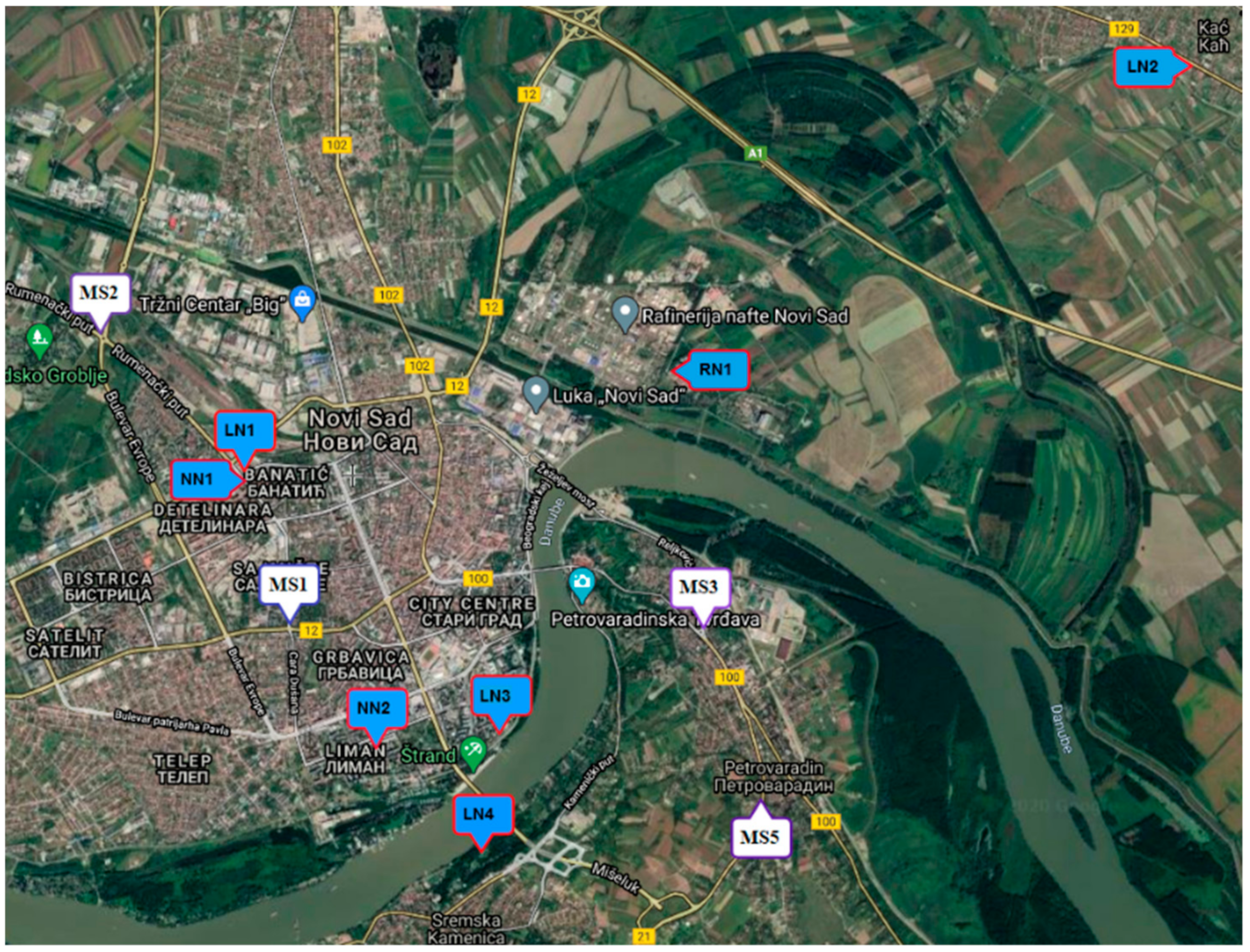

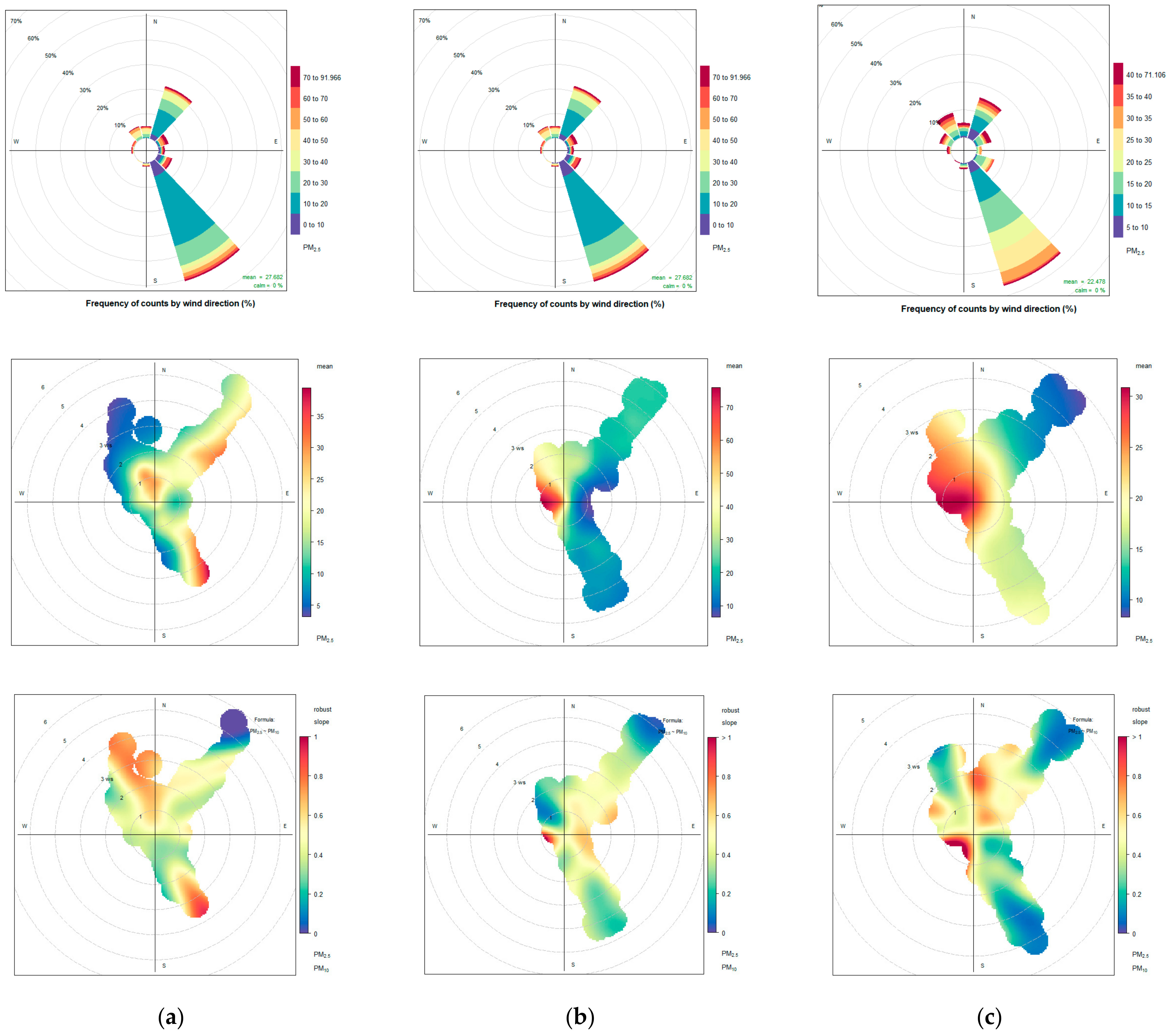



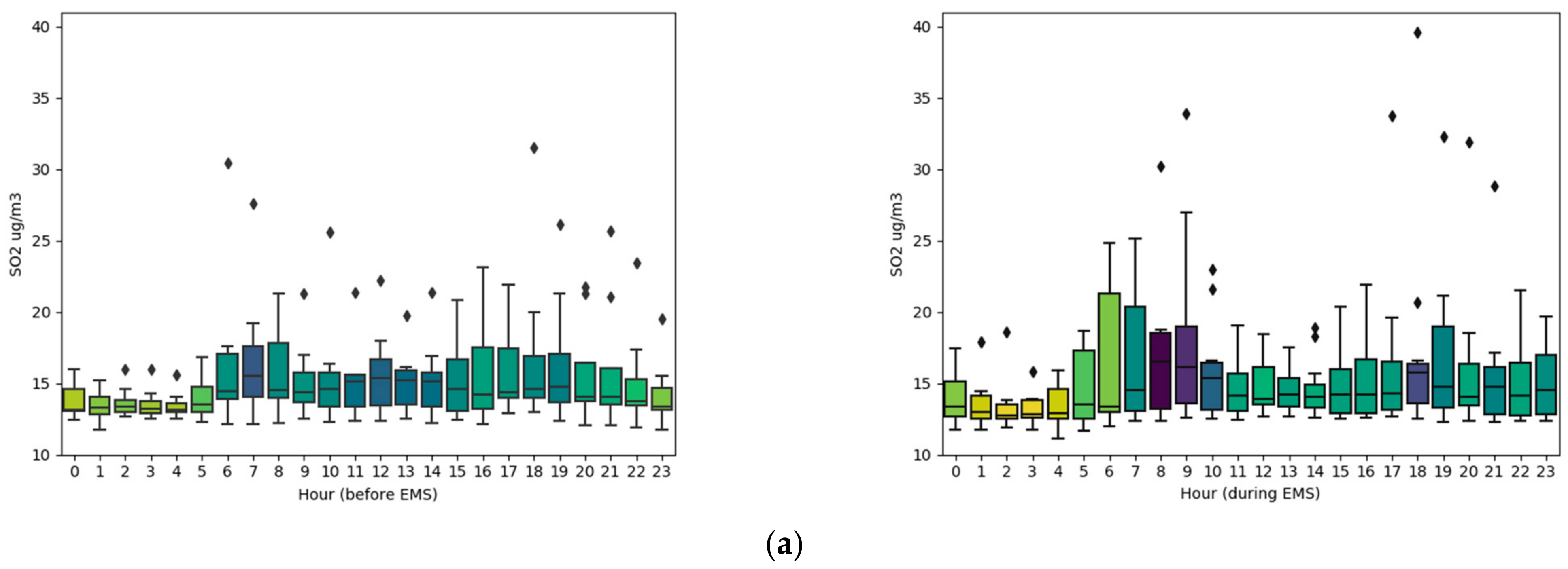
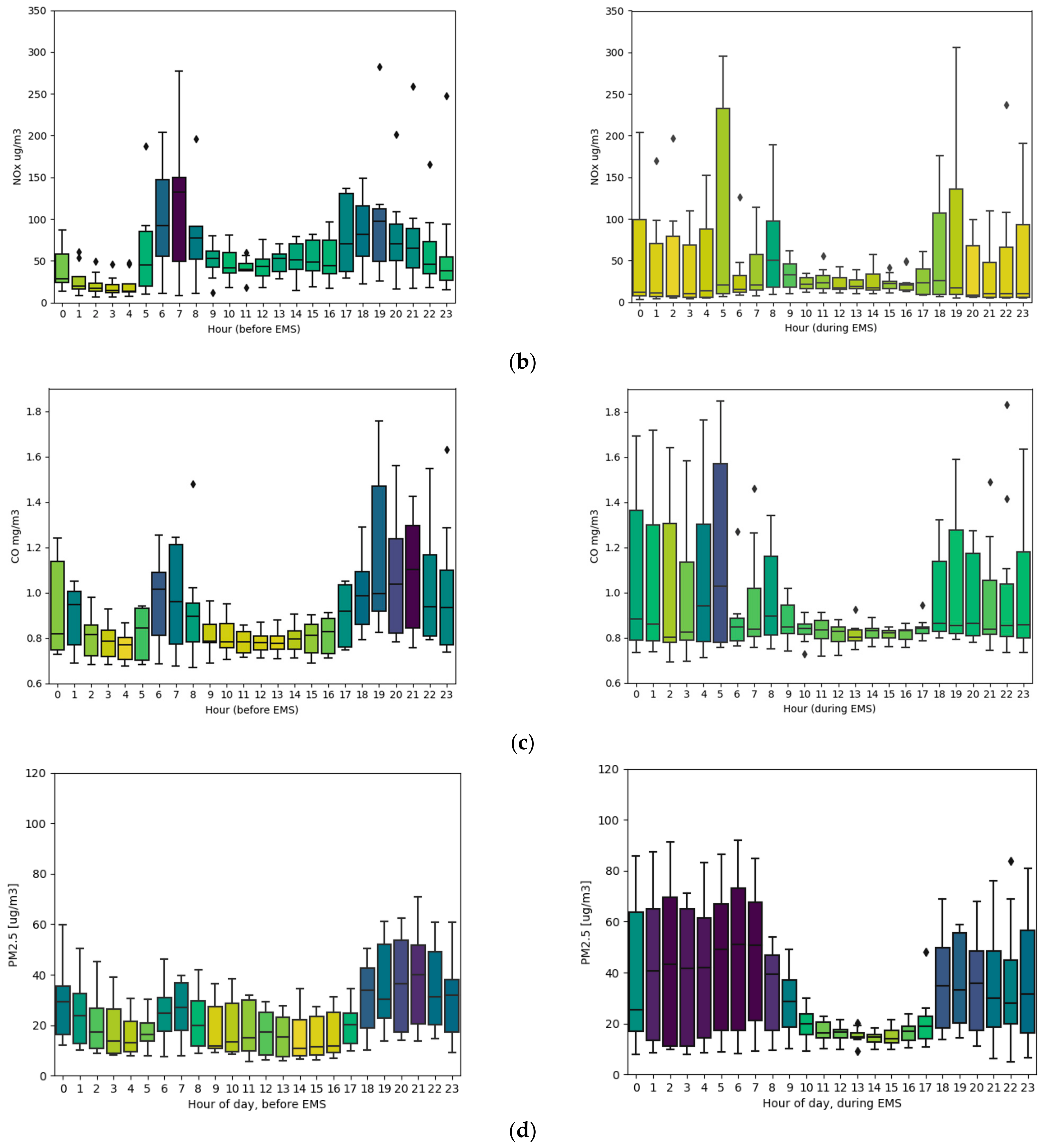
| LN1 | LN2 | LN3 | LN4 | NN1 | |||||||||||
|---|---|---|---|---|---|---|---|---|---|---|---|---|---|---|---|
| Period | BEMS | EMS | EMS* | BEMS | EMS | EMS* | BEMS | EMS | EMS* | BEMS | EMS | EMS* | BEMS | EMS | EMS* |
| Mean | 30.97 | 43.97 | 32.59 | 23.77 | / | 24.97 | 17.72 | 39.69 | 28.88 | 25.21 | 29.49 | 20.38 | 36.83 | 49.58 | 41.89 |
| St.dev. | 13.24 | 43.56 | 13.84 | 10.31 | / | 22.30 | 7.62 | 40.17 | 12.49 | 21.85 | 37.64 | 9.83 | 16.89 | 39.95 | 20.30 |
| Median | 28.50 | 33.00 | 30.50 | 21.10 | / | 17.00 | 16.05 | 31.00 | 28.50 | 20.40 | 19.00 | 17.00 | 33.35 | 36.50 | 36.30 |
| MIN | 14.00 | 13.00 | 13.00 | 8.70 | / | 5.00 | 7.30 | 6.00 | 6.00 | 11.70 | 4.00 | 4.00 | 9.70 | 13.20 | 13.20 |
| MAX | 62.00 | 243.00 | 66.00 | 44.60 | / | 122.00 | 40.90 | 219.00 | 51.00 | 122.60 | 209.00 | 42.00 | 85.10 | 231.60 | 88.50 |
| LN2 | LN3 | LN4 | NN1 | |||||||||
|---|---|---|---|---|---|---|---|---|---|---|---|---|
| Period | BEMS | EMS | EMS* | BEMS | EMS | EMS* | BEMS | EMS | EMS* | BEMS | EMS | EMS* |
| Mean | 19.08 | / | 19.95 | 12.09 | 25.22 | 19.44 | 18.71 | 19.95 | 14.77 | 20.95 | 23.95 | 21.42 |
| St.dev. | 8.26 | / | 17.52 | 5.19 | 21.25 | 8.51 | 14.85 | 21.06 | 7.63 | 10.08 | 15.44 | 10.65 |
| Median | 17.00 | / | 14.00 | 10.95 | 20.35 | 19.00 | 14.80 | 14.00 | 12.40 | 18.30 | 18.50 | 17.60 |
| MIN | 7.00 | / | 4.00 | 5.00 | 4.10 | 4.10 | 8.00 | 3.20 | 3.20 | 6.80 | 7.30 | 7.30 |
| MAX | 36.00 | / | 97.60 | 28.00 | 99.00 | 35.00 | 84.00 | 99.00 | 33.60 | 50.50 | 86.40 | 48.20 |
| MS1 | MS2 | MS3 | MS5 | |||||
|---|---|---|---|---|---|---|---|---|
| Campaign | BEM | EM | BEM | EM | BEM | EM | BEM | EM |
| Mean | 24.05 | 25.85 | 26.79 | 31.02 | 26.27 | 28.72 | 23.50 | 21.31 |
| St.dev. | 17.70 | 16.71 | 20.94 | 23.54 | 16.14 | 16.86 | 15.50 | 6.38 |
| Median | 21.46 | 22.13 | 22.54 | 23.61 | 26.61 | 24.02 | 20.01 | 21.11 |
| MIN | 2.56 | 6.37 | 1.90 | 4.47 | 6.50 | 8.28 | 7.99 | 11.49 |
| MAX | 74.21 | 74.26 | 78.84 | 88.54 | 66.34 | 75.64 | 61.83 | 39.14 |
| 25th perc. | 8.73 | 13.24 | 7.97 | 12.15 | 11.03 | 16.34 | 12.59 | 17.08 |
| 75th perc. | 34.52 | 35.26 | 40.81 | 47.50 | 36.07 | 38.12 | 30.13 | 24.70 |
Publisher’s Note: MDPI stays neutral with regard to jurisdictional claims in published maps and institutional affiliations. |
© 2021 by the authors. Licensee MDPI, Basel, Switzerland. This article is an open access article distributed under the terms and conditions of the Creative Commons Attribution (CC BY) license (http://creativecommons.org/licenses/by/4.0/).
Share and Cite
Davidović, M.; Dmitrašinović, S.; Jovanović, M.; Radonić, J.; Jovašević-Stojanović, M. Diurnal, Temporal and Spatial Variations of Main Air Pollutants Before and during Emergency Lockdown in the City of Novi Sad (Serbia). Appl. Sci. 2021, 11, 1212. https://doi.org/10.3390/app11031212
Davidović M, Dmitrašinović S, Jovanović M, Radonić J, Jovašević-Stojanović M. Diurnal, Temporal and Spatial Variations of Main Air Pollutants Before and during Emergency Lockdown in the City of Novi Sad (Serbia). Applied Sciences. 2021; 11(3):1212. https://doi.org/10.3390/app11031212
Chicago/Turabian StyleDavidović, Miloš, Sonja Dmitrašinović, Maja Jovanović, Jelena Radonić, and Milena Jovašević-Stojanović. 2021. "Diurnal, Temporal and Spatial Variations of Main Air Pollutants Before and during Emergency Lockdown in the City of Novi Sad (Serbia)" Applied Sciences 11, no. 3: 1212. https://doi.org/10.3390/app11031212
APA StyleDavidović, M., Dmitrašinović, S., Jovanović, M., Radonić, J., & Jovašević-Stojanović, M. (2021). Diurnal, Temporal and Spatial Variations of Main Air Pollutants Before and during Emergency Lockdown in the City of Novi Sad (Serbia). Applied Sciences, 11(3), 1212. https://doi.org/10.3390/app11031212







